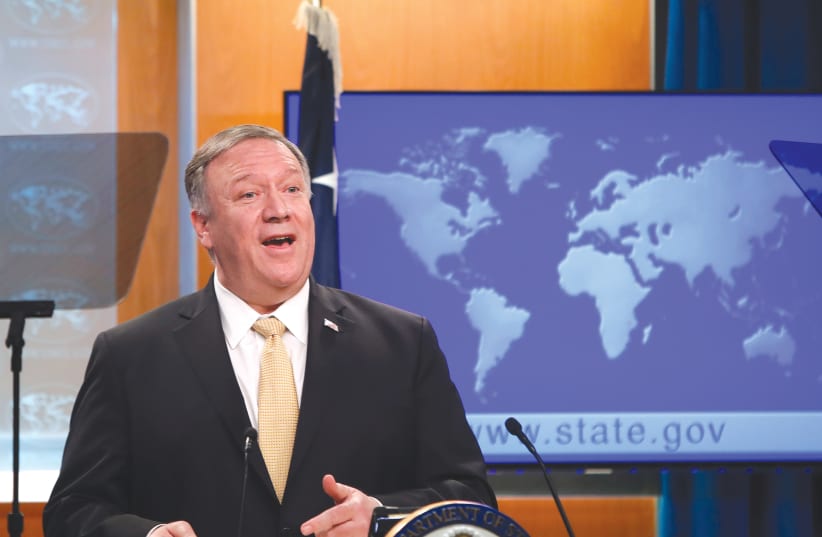A diplomatic game of ping-pong is upon us. US Secretary of State Antony Blinken has reversed his predecessor Mike Pompeo’s 2019 declaration regarding the legality of Jewish residency communities in the region of Judea and Samaria.
No longer is it United States policy that “the establishment of Israeli civilian settlements in the West Bank is not per se inconsistent with international law.”
On February 23, Blinken announced that “it’s been longstanding US policy under Republican and Democratic administrations alike that new settlements are counterproductive to reaching an enduring peace. They’re also inconsistent with international law.”
Not only did he reach the wrong conclusion, but he also presented his country’s earlier diplomatic positions incorrectly.
Of course, one could ask Blinken whether “old” settlements are legal or whether it is only “any expansion” of Jewish communities that would be illegal. That, however, might trip him up. What could also stump him up is former secretary of state Madeleine Albright’s television interview with Matt Lauer on NBC’s Today show on October 1, 1997. When pressed on the legal aspect of building beyond the Green Line, she admitted, “It’s legal.”
Also, State Department spokesman James Rubin declared on September 17, 1997, that while moving Jews into the Ras al-Amud housing project “is not helpful...we don’t think this is a question of law.”
Fifteen years earlier, in February 1981, president Ronald Reagan stated that the settlements were “not illegal,” despite the infamous 1978 Hansell Memorandum that president Jimmy Carter demanded be formulated.
Sleight of hand
TO TRULY COMPREHEND the State Department’s latest sleight of hand, I would suggest that there is at least one chapter of diplomatic history involving the State Department, the Jewish Agency, and the then-Transjordan entity that could enlighten us on the subject.
The text of the Balfour Declaration of 1917 had been pre-approved by US president Woodrow Wilson, who affirmed “that Palestine should become a Jewish state.” The United States House of Representatives and the Senate adopted resolutions supporting the mandate in 1922. The December 3, 1924, convention signed between Great Britain and the United States also confirmed America’s acknowledgment of the Mandate, which declared the Jewish people’s national home would be established in Palestine.
The borders of that Jewish national home were from the Mediterranean Sea to at least the Jordan River, as fixed by Article 25 of the Mandate. That clause permitted England to “withhold” or “postpone” certain provisions of the Mandate being applied to the territory east of the Jordan River, originally to be included in the Mandate area. Transjordan continued to be administered as part of the Palestine Mandate nonetheless.
The mandate’s Article 6 guaranteed that Jews possessed the right to “close settlement on the land,” a right to be “facilitated and encouraged.” That leaves us with the task of identifying that “land.”
At the time, the Arabs viewed themselves not as “Palestinians,” but as “Southern Syrians,” and demanded, on several representative occasions, “that there should be no separation of the southern part of Lebanon [i.e., the Palestine Mandate territory] from the Syrian country.” Even Yasser Arafat declared over Voice of Palestine on November 18, 1978, that “Palestine is southern Syria, and Syria is northern Palestine.”
ON MAY 25, 1946, Transjordan became the “Hashemite Kingdom of Transjordan.” Subsequently, King Abdullah applied for membership in the newly formed United Nations. The Soviet Union vetoed the request as his country was not “fully independent” of British control while British troops remained stationed there.
As for the United States, the documentation indicates that the State Department declined to approve Jordan’s membership based on a legal problem. It was only after Israel was established that Jordan was accepted.
Moreover, America only recognized it as a state in 1949. The State Department’s reasoning was that the Anglo-American Palestine Mandate Convention, mentioned above, permitted the US to delay any unilateral British action to terminate the mandate unless Jews obtained their state as well.
The State Department accepted the Jewish Agency’s claim that Transjordan had been part of the original Palestine Mandate. Since the mandate’s unique purpose was solely to reconstitute the historic Jewish national home, until that was accomplished, no territory could be fully separated from the mandate.
The Palestine Mandate’s territorial conceptualization, linking both statehood and land, was that Jordan could not exist without first resolving the matter of a Jewish national home. The two were intertwined.
Internal State Department deliberations arrived at the conclusion that the original status of Transjordan was territory within the Mandate of Palestine area. As such, the territory east of the Jordan River had the potential to become part of the historic Jewish homeland. A Jewish entity had to be resolved before Jordan could come into being.
Secretary of State James F. Byrnes spoke out against premature recognition of Transjordan and insisted that Jordan’s membership application should not be considered until the question of Palestine as a whole was addressed.
Members of Congress also became involved, introducing resolutions demanding the postponement of any international determination of the status of Transjordan until the future status of Palestine as a whole was determined.
In essence, Jordan’s independence in 1946 was challenged based on the League of Nations 1922 decision that a separate geopolitical entity other than the Jewish national home had not been formed east of the Jordan River. “Jewish Palestine” stretched from the Mediterranean Sea to the Jordan River. In fact, during the General Assembly deliberations on Palestine, there were suggestions to incorporate part of Transjordan’s territory into the proposed Jewish state.
To return to 2024, not only has Blinken erred in reversing Pompeo’s proclamation, but there can be no doubt that Judea and Samaria, lying west of the Jordan River, are territories legally and legitimately proper for Jewish residence and construction.
The writer is a researcher, analyst, and opinion commentator on political, cultural, and media issues.

